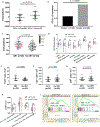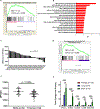Molecular Profiling Reveals Unique Immune and Metabolic Features of Melanoma Brain Metastases
- PMID: 30787016
- PMCID: PMC6497554
- DOI: 10.1158/2159-8290.CD-18-1489
Molecular Profiling Reveals Unique Immune and Metabolic Features of Melanoma Brain Metastases
Abstract
There is a critical need to improve our understanding of the pathogenesis of melanoma brain metastases (MBM). Thus, we performed RNA sequencing on 88 resected MBMs and 42 patient-matched extracranial metastases; tumors with sufficient tissue also underwent whole-exome sequencing, T-cell receptor sequencing, and IHC. MBMs demonstrated heterogeneity of immune infiltrates that correlated with prior radiation and post-craniotomy survival. Comparison with patient-matched extracranial metastases identified significant immunosuppression and enrichment of oxidative phosphorylation (OXPHOS) in MBMs. Gene-expression analysis of intracranial and subcutaneous xenografts, and a spontaneous MBM model, confirmed increased OXPHOS gene expression in MBMs, which was also detected by direct metabolite profiling and [U-13C]-glucose tracing in vivo. IACS-010759, an OXPHOS inhibitor currently in early-phase clinical trials, improved survival of mice bearing MAPK inhibitor-resistant intracranial melanoma xenografts and inhibited MBM formation in the spontaneous MBM model. The results provide new insights into the pathogenesis and therapeutic resistance of MBMs. SIGNIFICANCE: Improving our understanding of the pathogenesis of MBMs will facilitate the rational development and prioritization of new therapeutic strategies. This study reports the most comprehensive molecular profiling of patient-matched MBMs and extracranial metastases to date. The data provide new insights into MBM biology and therapeutic resistance.See related commentary by Egelston and Margolin, p. 581.This article is highlighted in the In This Issue feature, p. 565.
©2019 American Association for Cancer Research.
Conflict of interest statement
CONFLICTS OF INTEREST
M.A. Davies has served on advisory committees for Roche/Genentech, BMS, Novartis, GSK, Sanofi-Aventis, and Vaccinex and has been the PI of funded research grants to his institution by Roche/Genentech, GSK, Sanofi-Aventis, Merck, Myriad, and Oncothyreon. R.J. DeBerardinis is an adviser at Agios Pharmaceuticals. M.T. Tetzlaff has served on advisory committees for Novartis, Myriad Genetics, and Seattle Genetics. A.J. Lazar has served on advisory committees and/or scientific advisory boards for BMS, GSK/Novartis, Roche/Genentech, MedImmune/AstraZeneca, Bayer, Guardant and ArcherDX. J.E. Gershenwald has served on advisory committees and/or as a consultant for Bristol-Myers Squibb, Novartis, Merck, Syndax, and Castle Biosciences. No potential conflicts of interest were disclosed by other authors.
Figures






Comment in
-
Metabolic Checkpoint of Immune Cells in Melanoma Brain Metastases.Cancer Discov. 2019 May;9(5):581-583. doi: 10.1158/2159-8290.CD-19-0249. Cancer Discov. 2019. PMID: 31043411
References
-
- Glitza IC, Heimberger AB, Sulman EP, Davies MA, Hayat M: Prognostic factors for survival in melanoma patients with brain metastases in Brain Metastases from Primary Tumors, Volume 3: Epidemiology, Biology, and Therapy of Melanoma and Other Cancers. Boston, MA, Academic Press; 2016. pp. 267–292.
-
- Long GV, Atkinson V, Menzies AM, Lo S, Guminski AD, Brown MP, Gonzalez MM, Diamante K, Sandhu SK, Scolyer RA, Emmett L, McArthur GA. A randomized phase II study of nivolumab or nivolumab combined with ipilimumab in patients (pts) with melanoma brain metastases (mets): The Anti-PD1 Brain Collaboration (ABC). J Clin Oncol. 2017;35:9508–9508.
-
- Goldberg SB, Gettinger SN, Mahajan A, Chiang AC, Herbst RS, Sznol M, Tsiouris AJ, Cohen J, Vortmeyer A, Jilaveanu L, Yu J, Hegde U, Speaker S, Madura M, Ralabate A, Rivera A, Rowen E, Gerrish H, Yao X, Chiang V, Kluger HM. Pembrolizumab for patients with melanoma or non-small-cell lung cancer and untreated brain metastases: early analysis of a non-randomised, open-label, phase 2 trial. Lancet Oncol. 2016;17:976–983. - PMC - PubMed
-
- Davies MA, Saiag P, Robert C, Grob JJ, Flaherty KT, Arance A, Chiarion-Sileni V, Thomas L, Lesimple T, Mortier L, Moschos SJ, Hogg D, Marquez-Rodas I, Del Vecchio M, Lebbe C, Meyer N, Zhang Y, Huang Y, Mookerjee B, Long GV. Dabrafenib plus trametinib in patients with BRAF(V600)-mutant melanoma brain metastases (COMBI-MB): a multicentre, multicohort, open-label, phase 2 trial. Lancet Oncol. 2017;18:863–873. - PMC - PubMed
Publication types
MeSH terms
Substances
Grants and funding
- P30 CA016672/CA/NCI NIH HHS/United States
- R01 CA187076/CA/NCI NIH HHS/United States
- R01 CA154710/CA/NCI NIH HHS/United States
- R25 NS070694/NS/NINDS NIH HHS/United States
- R01 CA216426/CA/NCI NIH HHS/United States
- R01 CA121118/CA/NCI NIH HHS/United States
- P50 CA093459/CA/NCI NIH HHS/United States
- UL1 TR000371/TR/NCATS NIH HHS/United States
- U01 CA167234/CA/NCI NIH HHS/United States
- R01 CA220297/CA/NCI NIH HHS/United States
- HHMI/Howard Hughes Medical Institute/United States
- U01 CA179674/CA/NCI NIH HHS/United States
- P30 CA125123/CA/NCI NIH HHS/United States
- R35 CA220449/CA/NCI NIH HHS/United States
- TL1 TR000369/TR/NCATS NIH HHS/United States
- T32 CA009666/CA/NCI NIH HHS/United States
LinkOut - more resources
Full Text Sources
Other Literature Sources
Medical
Molecular Biology Databases

